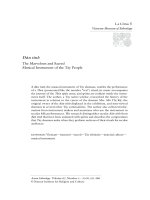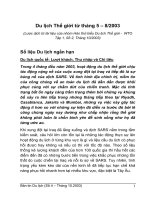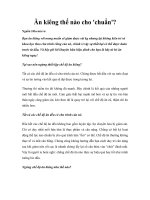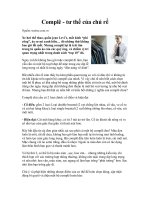Tài liệu Coaching Manual: The Definitive Guide to the Process, Principles & Skills of Personal Coaching pot
Bạn đang xem bản rút gọn của tài liệu. Xem và tải ngay bản đầy đủ của tài liệu tại đây (1.22 MB, 257 trang )
The
Coaching
Manual
"In a knowledge worker age, coaching is mainstreamed.
The Coaching Manual
is the most current, comprehensive,
practical, best-illustrated coaching source I have ever seen.
It compellingly teaches the mindset of keeping the
responsibility on the coachee combined with a powerful,
realistic skillset."
Dr. Stephen R. Covey, author of The 7 Habits of Highly Effective People
Books to make you better
Books to make you better. To make you be better, do better,
feel better. Whether you want to upgrade your personal skills
or change your job, whether you want to improve your
managerial style, become a more powerful communicator, or
be stimulated and inspired as you work.
Prentice Hall Business is leading the field with a new breed of
skills, careers and development books. Books that are a cut
above the mainstream – in topic, content and delivery – with
an edge and verve that will make you better, with less effort.
Books that are as sharp and smart as you are.
Prentice Hall Business.
We work harder – so you don’t have to.
For more details on products, and to contact us, visit
www.business-minds.com
www.yourmomentum.com
The
Coaching
Manual
The definitive guide to the process, principles
and skills of personal coaching
Julie Starr
an imprint of
Pearson Education
London • New York • Toronto • Sydney • Tokyo • Singapore • Hong Kong • Cape Town
New Delhi • Madrid • Paris • Amsterdam • Munich • Milan • Stockholm
PEARSON EDUCATION LIMITED
Head Office:
Edinburgh Gate
Harlow CM20 2JE
Tel: +44 (0)1279 623623
Fax: +44 (0)1279 431059
London Office:
128 Long Acre
London WC2E 9AN
Tel: +44 (0)20 7447 2000
Fax: +44 (0)20 7447 2170
Website: www.business-minds.com
www.yourmomentum.com
First published in Great Britain in 2003
© Pearson Education Limited 2003
The right of Julie Starr to be identified as Author
of this Work has been asserted by her in accordance
with the Copyright, Designs and Patents Act 1988.
ISBN 0 273 66193 0
British Library Cataloguing in Publication Data
A CIP catalogue record for this book can be obtained from the British Library.
All rights reserved; no part of this publication may be reproduced, stored
in a retrieval system, or transmitted in any form or by any means, electronic,
mechanical, photocopying, recording, or otherwise without either the prior
written permission of the Publishers or a licence permitting restricted copying
in the United Kingdom issued by the Copyright Licensing Agency Ltd,
90 Tottenham Court Road, London W1P 0LP. This book may not be lent,
resold, hired out or otherwise disposed of by way of trade in any form
of binding or cover other than that in which it is published, without the
prior consent of the Publishers.
10 9 8 7 6 5 4 3 2 1
Designed by Claire Brodmann Book Designs, Lichfield, Staffs
Typeset by Northern Phototypesetting Co. Ltd, Bolton
Printed and bound in Great Britain by Biddles Ltd, Guildford & King’s Lynn
The Publishers’ policy is to use paper manufactured from sustainable forests.
Acknowledgements ix
Chapter 1 Introduction 1
The purpose of this book 2
What is personal coaching? 3
Coaching: In business 8
Personal coaching: Life/lifestyle 10
A comparison of coaching and therapy 11
Summary: Introduction 13
Chapter 2 Collaborative coaching 15
What does collaborative coaching mean? 16
Non-directive versus directive language 16
Attributes of a good coach 22
Summary: Collaborative coaching 26
Chapter 3 Coaching principles or beliefs 29
Operating principles for coaches 30
Maintain a commitment to support the individual 31
v
Contents
Build the coaching relationship on truth, openness and trust 36
The coachee is responsible for the results they are generating 39
The coachee is capable of much better results than they are currently
generating
43
Focus on what the coachee thinks and experiences 45
Coachees can generate perfect solutions 47
The conversation is based on equality 51
Summary: Coaching principles or beliefs 52
Chapter 4 Coaching process and structure 55
Four stages of a coaching assignment 57
Stage one – establish the context for coaching 59
Stage two – create understanding and direction 72
Stage three – review/confirm learning 85
Stage four – completion 92
A framework for coaching 99
Summary: Coaching process and structure 102
Chapter 5 Fundamental skills of coaching 105
Can anyone coach? 106
Skill one – building rapport or relationship 107
Skill two – different levels of listening 128
Skill three – using intuition 141
Skill four – asking questions 147
Skill five – giving supportive feedback 163
Summary: Fundamental skills of coaching 183
CONTENTS
vi
Chapter 6 Barriers to coaching 185
Physical and environmental barriers 186
Barriers relating to the coach’s behaviour and belief 189
Summary: Barriers to coaching 213
Chapter 7 Summary and close 217
Key points of learning 218
The future of coaching 222
Taking your learning forward 222
Appendix 1 Coaching overview document 225
Index 233
CONTENTS
vii
There are many people who have contributed to the development of the ideas and thoughts
in the book and I hope I’ve remembered to acknowledge most of them. So I would express
gratitude for the work of the following people; Anthony Robbins, Stephen Covey, Richard
Bandler, John Grinder, Deepak Chopra, M. Scott Peck, Landmark Education, Brian Tracey,
Frank Daniels and Milton H. Erickson.
I’d also like to thank Marcia Yudkin, Richard Watts, Scott Downing, Joss Kang, Julia Whitely,
Mike Fryer and Rachael Stock for their challenges, thoughts, and ideas in preparation of
the text.
ix
Acknowledgements
Introduction
chapter
P
ersonal coaching of other people is a wonderfully rewarding thing to
do. Coaching is about enabling people to create change through learning. It’s
also about people being more, doing more, achieving more and, above all,
contributing more. In our constant quest for success, happiness and fulfilment,
coaching provides a way by which one person can truly support the progress of another.
So whether you’re reading this book because you want to begin coaching, or simply
coach more effectively, I hope you’ll enjoy reading it, and find that it supports you. The
field of coaching needs more of us to constantly develop our own learning, and so
improve general standards of coaching everywhere.
The purpose of this book
This book explains the principles and approaches of personal coaching and shows you
how to apply them in any coaching situation – from business coaching for performance,
to complete life coaching. For those already coaching, the manual offers new insights
and fresh ideas. For the brand new coach, the manual is a practical guide to begin and
support your training. For the busy manager, the manual gives techniques to use with
your team.
The manual covers the principles and beliefs that underpin coaching, describes the
actual coaching process stage by stage, and gives fresh perspectives on the skills you
need to develop. You’ll also get practical guidance on what works and what simply gets
in the way of great coaching.
If you are interested in enlisting the services of a coach, either for yourself or others,
you’ll also gain insight into coaching practices that will support you as a client.
Counsellors, or those thinking of going into counselling, will also find relevant
information and guidance. Many of our core principles and skills are the same. Princi-
ples of integrity, and a person’s responsibility for their actions are common to both.
Skills of listening, questioning, establishing relationships, are also key within both
professions.
THE COACHING MANUAL
2
A manual that helps you to learn
This book provides you with a practical, enjoyable way to learn while you read. You’ll
find clearly marked sections together with exercises and examples that will help you
develop the skills, perspectives and beliefs of a good coach. Whether you’re new to
coaching, or have been coaching forever – this book will help you develop further. Some
exercises are easy, while some are a real challenge. I invite you to discover which ones
benefit your learning the most.
The exercises and learning routines can be done in your normal, everyday circumstances
– so you don’t have to be coaching in order to learn coaching! Some exercises can be
done alone, others in the company of colleagues or friends. Often, you can try out the
new behaviours or routines without anyone knowing you’re actually learning while
you’re with them.
There are also routines and language that you can use in coaching sessions, to help you
to be really effective in those conversations. Once you’ve finished reading, you can use
the book as an ongoing point of reference, to help you plan your coaching, brush up on
your skills, and even spot problems as they occur.
What is personal coaching?
From early forms of transportation, i.e. stagecoach, or rail coach, the word ‘coaching’ lit-
erally means to transport someone from one place to another. One thing that all forms
of coaching seem to have in common is that people are using
it to help them move forward or create change.
Put simply, coaching is a conversation, or series of conversa-
tions, one person has with another. The person who is the
coach intends to produce a conversation that will benefit the
other person, the coachee, in a way that relates to the
coachee’s learning and progress. Coaching conversation might happen in many different
ways, and in many different environments.
INTRODUCTION
3
Put simply, coaching is a
conversation, or series of
conversations, one person
has with another.
Coaching has many different forms or expressions, within many different areas of
human activity. There are sports coaches, musical coaches, relationship coaches, voice
coaches, writing coaches and time-management coaches, to name but a few. It appears
that whatever you might be doing, there’s a coach out there to help you do it!
The person who decides whether a conversation was a coaching conversation or not is
normally the person who is being coached. If someone acknowledges the following to be
true after a conversation they would probably accept that it was coaching:
➡ The focus of the conversation was primarily themselves and their circumstances.
➡ Their thinking, actions and learning benefited significantly from the conversation.
➡ They were unlikely to have had those benefits in thinking or learning within that
time frame if the conversation hadn’t happened.
So when we apply these simple principles, we realize we’ve been coaching each other
forever. For generations, whether it’s over the garden wall, a cup of tea or a beer in the
pub, we’ve talked about what happens in our lives. We share our troubles and our
dreams. We listen to each other, and we advise each other. Sometimes this process really
helps. Maybe we realize a solution, make a decision, or perhaps the conversation simply
makes us feel better.
Testing questions Where are you already coaching?
Of the following, which do you do regularly?
➡ Give friends or colleagues advice.
➡ Listen to others’ problems, to help and support them.
➡ Explain to other people how to do something better.
➡ Train others in new knowledge or skills.
➡ Manage the work of others.
➡ Give other people feedback or observations of their behaviour so that they can get
better at something.
➡ Conduct job appraisals, or assessments of people’s work performance.
THE COACHING MANUAL
4
➡ Give others formal counselling.
➡ Perform personal coaching on a 1:1 basis.
This book will help improve general standards of coaching wherever they occur. Whether
your coaching conversations are planned or not, this book gives you support and practical
guidance so that those conversations create really great results.
Where does coaching come from?
The most recognized forms of coaching come from the sporting world. Having evolved
over thousands of years, the figure of a sports coach working alongside top athletes is
accepted without question. There may seem to be a contradiction in having someone
who can’t do what you can do, as well as you can do it, help you to improve. Andre
Agassi’s coach can’t play tennis like Agassi does, and yet he plays a vital role in improv-
ing Agassi’s game. So why does Agassi get help from a lesser player?
The reason is quite simple: because coaching is proven to work. It improves the results
an individual is generating. A tennis coach needs coaching skills more than they need to
be a good tennis player themselves. By applying principles of observation and feedback,
sports coaches can make the difference between a world-beater and an ‘also-ran’.
Strangely, where someone has all the skills needed to produce a result themselves, they
can’t always help someone else to do it. For example, a world-class tennis player might
have real difficulty in coaching someone else to the same standard. This is because the
perspectives and skills of a coach are essentially different from those of a tennis player.
If a tennis player wants to become a great coach, they must begin to focus on develop-
ing coaching behaviours and skills. It’s not enough to be able to ‘do’ – you have to be
able to coach.
The same principle applies in business. Coaches work alongside individuals to help
improve their performance at work, regardless of whether or not they could do that work
themselves. What a coach can do, is help someone see opportunities for improvement,
as well as practical ways forward.
INTRODUCTION
5
How does personal coaching happen?
A personal coach will often work within arranged coaching sessions. The coach will
normally use a blend of observation, talking, listening, questioning and reflecting back
to the individual they are working with. If the situation or circumstances are suitable, a
coach might also use other media, such as telephone, or e-mail.
Coaching might consist of two people talking in a room about things the coachee wants
to change. This is sometimes called ‘off-line’ coaching. It might also be one person
observing another person doing something, e.g. talking to customers or colleagues, then
discussing that afterwards. This can be called on-line coaching.
Other coaching conversations might easily happen outside a formal coaching session.
For example, a casual discussion around a challenging situation or goal may easily
produce a conversation in which the individual receives coaching.
Whether coaching happens in the workplace or outside, the two activities can easily merge
into the same thing. It’s often impossible to separate work from life anyway. People’s lives
don’t package themselves into neat little bundles – job, home, money, health, etc. Our lives
seem to contain themes that run through them like common-coloured thread. If you’re not
happy at work, that’s likely to show up somewhere else. If you’re not feeling healthy or full
of energy, then that’s likely to be mirrored elsewhere, e.g. in your relationships or social life.
The coaching relationship
The role of coach provides a kind of support distinct from any other. A coach will focus
solely on an individual’s situation with the kind of attention and commitment that the
individual will rarely experience elsewhere.
If you imagine yourself being coached, you will perhaps appreciate why so many people
engage the services of a coach. This person, your coach, will listen to you, with a curios-
ity to understand who you are, what you think and generally how you experience the
world. Your coach will reflect back to you, with the kind of objective view that creates
real clarity. During conversations, your coach will encourage you to rise to challenges,
overcome obstacles and move into action.
THE COACHING MANUAL
6
What’s most important during that conversation is you, your success, happiness and
ultimate fulfilment. Having worked to establish exactly what you want to achieve from
coaching, those goals and objectives become the focus for the conversation. As a conse-
quence, the only agenda happening in the conversation is your agenda, which your coach
will often guard more closely than you do. When you’re ready to quit, no longer care that
you wanted to get that job, lose that weight, or have that
lifestyle, your coach stays committed to those goals.
When things don’t go well, your coach supports you. When
you experience success, your coach acknowledges your
achievements. Your coach will also help you to pinpoint
exactly what you did that worked so well, so that you can do
it again. A coaching relationship is like no other, simply because of its combination of
objective detachment and commitment to the goals of the individual.
Little wonder then that so many people are finding that coaching relationships can help
them develop and learn in ways that enable them to have or achieve what they really
want.
Learn to coach by being coached
One of the best ways to learn how to be a good coach is to be coached. You will experi-
ence what it feels like to be a coachee. You will understand what works and what doesn’t,
what feels right and what feels wrong. Surprisingly, that might not always be what you
expect. For example, as a coach, silence can be uncomfortable, whilst for a coachee, the
same silence can feel wonderful. A sense of rapid progress during a conversation can feel
great for the coach, and yet turbulent for the coachee. So if you’re serious about devel-
oping your coaching skills, I recommend you get some sort of coaching as part of your
development. As well as helping you develop as a coach, who knows, you might just find
there are other benefits for your personal goals as well!
INTRODUCTION
7
What’s most important
during that conversation is
you, your success,
happiness and ultimate
fulfilment.
Coaching: In business
Coaching is now big in business. Many organizations have come to realize that they can
improve both the performance and motivation of their people through coaching.
Increasingly, a ‘coaching’ style of management is preferred to the more traditional
approaches of ‘command and control’. Instead of managers directing people, giving
detailed instructions for what to do, and when to do it, they focus more on encouraging
people to think for themselves. When problems arise, those managers who coach don’t
automatically jump in and solve them. Instead, they challenge others to resolve situa-
tions. These managers provide support, feedback and guidance – but rarely answers.
Managers who coach often place as much importance on the development of people
reporting to them, as the tasks those people are performing. For the manager, this means
fewer queues of people at their desk asking what to do next (and much less worry if the
manager wants a two-week vacation). More of the manager’s focus is on establishing
conditions in which people can perform independently of the manager. Creating these
conditions means more time is spent on activities such as objective setting, one-to-one
meetings and team briefings. One-to-one meetings can now become coaching sessions,
as the manager adopts a more supportive, challenging and developmental approach.
Within team meetings, the manager can use the coaching skills of listening, questioning
and goal setting to encourage the group to take responsibility for situations. Over time,
colleagues learn more, perform better, and are generally more motivated by this nurtur-
ing style of leadership. As they become used to the manager’s expectations of them, they
begin to automatically respond to situations with more responsibility and empower-
ment.
Managers who coach improve productivity, morale and job satisfaction for their col-
leagues. Such managers, in turn, find that people are less dependent upon them, which
often reduces pressure, or frees up time to concentrate on other priorities. As more
businesses go multi-site or even global, the distance between managers and their teams
widens. Here, a coaching style is essential for both sanity and success. As a coaching
manager increases people’s independence, they directly reduce the dependency on
themselves to be on-site, supervising what’s happening.
THE COACHING MANUAL
8
Executive coaching
Organizations are now willing to invest in personal coaching for their senior managers
and executives. By improving the performance of the most influential people within the
organization, we are able to improve results at an organizational level. In short, we
create a positive influence on people who have influence. Senior managers encourage
typical behaviours and ways of being within the rest of their organization. What they say
and how they behave establishes similar standards for people who work for them.
Executive coaching is often done by coaches operating from outside the organization,
whose services are requested for an agreed duration or number of coaching sessions.
Increasingly, personal coaches are also being trained internally, as organizations realize
the opportunity this presents. Internal coaches normally cost less, and can operate very
effectively because of their knowledge of the operation.
Within business, situations that benefit from personal coaching might include the fol-
lowing:
➡ A manager with potential has been promoted and is having difficulty performing
in the new role.
➡ An individual is being groomed for senior management and needs to gain skills or
experience before they are able to make that move.
➡ An individual has relationship issues that are creating problems at an
organizational level.
➡ An organization has decided to align management behaviours to a set of core
values, e.g. integrity, collaboration or innovation. Some managers will need
coaching in these specific areas.
For example, during coaching a marketing director realizes he acts competitively against
the sales director. Because of the competition he feels, he encourages his own depart-
ment to withhold support and information from the sales department. This causes him
problems. Last year he mistimed the launch of a range of sports gear – bringing it out on
exactly the same day as their main competitors. Sales could have told him this was a
mistake, but they heard about the launch too late. During coaching, the marketing direc-
INTRODUCTION
9
tor improves his relationship with the sales director, and encourages his department to
adopt a more collaborative style.
This results in marketing telling sales more about their plans for the year, and what kind
of products they’re thinking of launching. As the flow and exchange of information
improves, so does the quality of products and sales campaigns.
Personal coaching: Life/lifestyle
Coaching outside the workplace is now becoming common. This type of personal coach-
ing is increasingly viewed as an acceptable form of support to anyone seeking to improve
specific areas of their life, or simply their quality of life in general. Personal fulfilment,
health, fitness, relationships, financial freedom are all common subjects for this type of
coaching.
Why do people choose life coaching?
Coaching makes a valuable contribution to the process of helping people to experience
life the way they want to experience it. For some people coaching can literally change
their lives for the better. With the support of a coach, people
can make clearer judgements about situations, learn more
from experiences, make better choices and implement more
effective decisions or actions.
For most of us, life can be difficult. We place tremendous pressure on ourselves to have
a lot, do a lot, and be generally successful in those areas of life we consider important.
That might be having a great job, having a great relationship, financial freedom – gener-
ally living a fabulous life.
I’m not going to debate whether that’s right or wrong, but I do believe that coaching is
a valuable counterbalance to that pressure. By enlisting the services of a coach, we can
often begin to focus on what really is important to us, and begin to shape what we need
to do to be more in line with that.
THE COACHING MANUAL
10
For some people coaching
can literally change their
lives for the better.
A comparison of coaching and therapy
There are obvious similarities between coaches and therapists. Both work with people,
both do a lot of talking and listening, both deal with people’s problems. However, whilst
coaching and therapy work within similar areas, they are not the same thing. Coaching
supports general life situations, improving our performance and creating desirable results.
Therapy normally focuses on specific, significant problems, e.g. trauma, mental illness etc.
For example, coaching would be appropriate in the following situations:
➡ Putting together a life plan, understanding our aims and goals.
➡ Finding ways to reduce stress in our lives.
➡ Building a life/work balance that fulfils us.
➡ Improving our ability to relate to others.
➡ Improving our awareness of ourselves.
➡ Improving our self-discipline and motivation.
➡ Improving our health and well-being routines, e.g. diet, exercise.
There are obviously many more. What you’ll notice from the above is that they are all
goal-based objectives. That is, we want something we don’t currently have and might
use a coach to support us in attaining that. In addition, the problems associated with the
goal might be making us unhappy, or even sick. For example, you’re working 12-hour
days on top of a 2-hour train journey and your relationship is in serious trouble because
of that. In such situations, coaching is now an option where, before, therapy might have
seemed to provide the only available support. Indeed, I would be surprised if a therapist
would welcome clients who simply want to create more structure around their job in
order to shorten their working day!
When coaching isn’t the answer
It is important that a coach recognizes inappropriate situations for coaching. Where
someone has issues that would be better addressed by a therapist, the coach should
INTRODUCTION
11
understand their own limitations. The skills and experience of the coach must be taken
into account. As a guide, a coach with no relevant, specialist skills should avoid the fol-
lowing situations:
➡ Ongoing dependency on class ‘A’ drugs, e.g. heroin, crack, cocaine.
➡ Significant drink problems, e.g. someone drinks to get through the day.
➡ Where someone has experienced violent or sexual abuse and needs further
support to deal with that.
➡ Where someone is abusing others, either physically or sexually.
➡ Mental illness, e.g. extreme and violent mood swings, ongoing depression, etc.
The skills of a therapist are often specialized to their area of therapy, e.g. addiction,
abuse, mental illness, etc. To support individuals with extreme conditions or situations,
a therapist will undergo specific training and development. They will normally have a
relevant model, processes and terminology to deal with that situation. For example,
Alcoholics Anonymous has a famous 12-step process that assists people to give up
drinking. Some psychiatrists study Freudian theory, etc.
You will also notice that there is more emphasis on the ‘problem’ within the above sit-
uations. Often, the focus of coaching is more on ‘solutions’; e.g. ‘What do you want
instead?’ The focus during therapy tends to be more about the original, underlying
problem, e.g. ‘What causes you to avoid relationships?’ A therapist may decide that an
in-depth assessment, analysis and diagnosis of someone’s problem is appropriate before
the individual can progress. Whilst a level of self-awareness is also valuable within
coaching, coaching doesn’t rely upon an in-depth level of self-awareness in order to
create results.
In summary, if a coach doesn’t feel equipped to cope, they should refer the individual to
a relevant specialist. If a coach does want to work in one of the above areas, then I would
encourage them to go and get the relevant training and support to do that.
THE COACHING MANUAL
12
Chapter summary Introduction
Coaching has been around forever. In more recent years, we’ve developed it into a pro-
fession. This profession focuses on techniques and methods that we understand make
a difference to the results someone else is getting. Coaching is now firmly established
as a way of supporting others in their quest to have what they really want, whether that
is a specific goal or simply a lifestyle they want to create. Learning to coach others is
both rewarding and fulfilling. And in an environment where so many of us face complex
life circumstances and decisions, coaching has a valuable contribution to make.
INTRODUCTION
13









